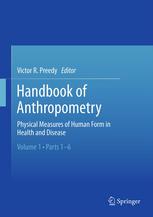Handbook of Anthropometry 2012
دانلود کتاب پزشکی کتاب راهنمای آنتروپومتری
| نویسنده |
Victor R. Preedy |
|---|
| تعداد صفحهها |
3107 |
|---|---|
| نوع فایل |
|
| حجم |
54 Mb |
| سال انتشار |
2012 |
89,000 تومان
اگرچه مفهوم اولیه آن نسبتاً ساده است – اندازه گیری بدن انسان و اجزای آن – انسان سنجی از روش ها و ابزارهای بی شماری استفاده می کند و برای اهداف مختلف مفید است، از درک تأثیر بیماری بر افراد گرفته تا ردیابی تغییرات در جمعیت در طول زمان اولین مرجع بین رشته ای در مورد این موضوع، راهنمای آنتروپومتری این زمینه گسترده را گرد هم می آورد: نظریه پایه و موضوعات بسیار تخصصی در انسان سنجی عادی و غیر طبیعی از نظر سلامت، پیشگیری از بیماری و مداخله. بیش از 140 فصل مستقل شامل نشانه های به روز، آخرین مطالعات در مورد روش های کامپیوتری، سیستم های شکل گیری، امپدانس بیوالکتریکی، داده های مربوط به بافت های فردی و متغیرهای کل بدن، و گزارش هایی از مناطق مختلف جهان است. فصل ها دارای نمودارها و تصاویر مفید هستند، ارجاعات متقابل به فصل های مربوطه گنجانده شده است، و نکات کلیدی برای درک آسان به صورت گلوله ای ارائه شده است. سیزده بخش راهنما با هم تمام جنبه های اصلی تمرین و تحقیق آنتروپومتریک را گرد هم می آورد، از جمله:
ابزارها و تکنیک.
· مراحل رشد از جنین تا پیری.
· بیماری های ژنتیکی، بیماری های متابولیک و سرطان.
· ورزش و تغذیه.
· گروه های قومی، فرهنگی و جغرافیایی.
· شرایط و شرایط خاص.
راهنمای آنتروپومتری افزودنی ارزشمند به کتابخانه های مرجع طیف گسترده ای از متخصصان سلامت، از جمله دانشمندان علوم سلامت، پزشکان، فیزیولوژیست ها، متخصصان تغذیه، و متخصصان تغذیه، پرستاران، محققان بهداشت عمومی، اپیدمیولوژیست ها، فیزیولوژیست های ورزشی و فیزیوتراپیست ها. همچنین برای دانشجویان و اساتید در سطح کالج در رشته های بهداشتی و همچنین برای سیاست گذاران و دانشمندان ارگونومی مفید است.
Although its underlying concept is a relatively simple one—the measurement of the human body and its parts—anthropometry employs a myriad of methods and instruments, and is useful for a variety of purposes, from understanding the impact of disease on individuals to tracking changes in populations over time. The first interdisciplinary reference on the subject, the Handbook of Anthropometry brings this wide-ranging field together: basic theory and highly specialized topics in normal and abnormal anthropometry in terms of health, disease prevention, and intervention. Over 140 self-contained chapters cover up-to-date indices, the latest studies on computerized methods, shape-capturing systems, and bioelectrical impedance, data concerning single tissues and whole-body variables, and reports from different areas of the world. Chapters feature helpful charts and illustrations, cross-references to related chapters are included, and key points are presented in bullet form for ease of comprehension. Together, the Handbook’s thirteen sections entail all major aspects of anthropometrical practice and research, including:
· Tools and techniques.
· Developmental stages, from fetus to elder.
· Genetic diseases, metabolic diseases, and cancer.
· Exercise and nutrition.
· Ethnic, cultural, and geographic populations.
· Special conditions and circumstances.
The Handbook of Anthropometry is an invaluable addition to the reference libraries of a broad spectrum of health professionals, among them health scientists, physicians, physiologists, nutritionists, dieticians, nurses, public health researchers, epidemiologists, exercise physiologists, and physical therapists. It is also useful to college-level students and faculty in the health disciplines, as well as to policymakers and ergonomists.




